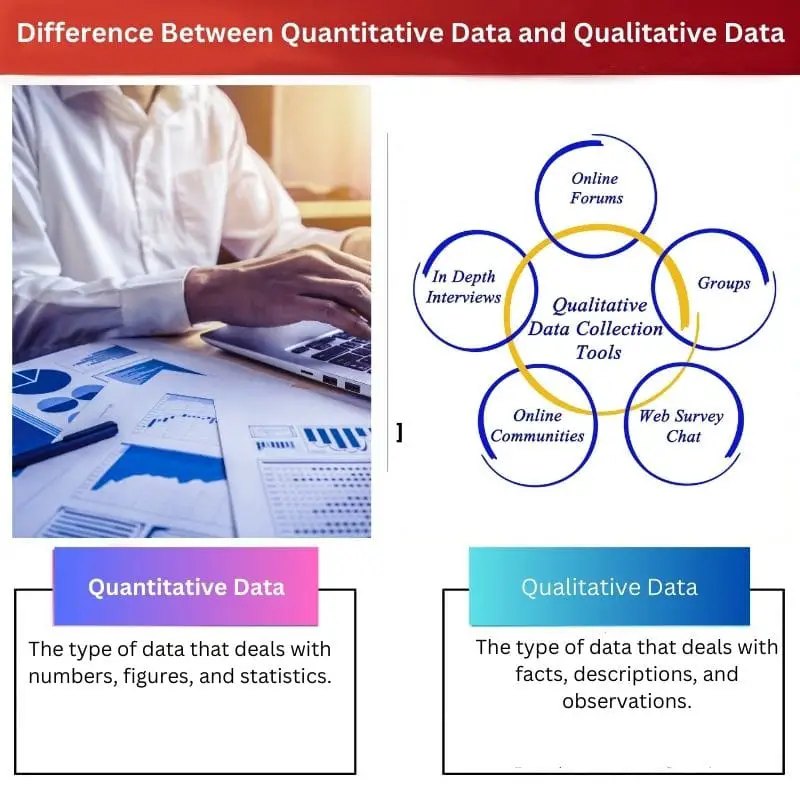On a broad basis, any data provided can be classified into two categories that are quantitative data and qualitative data. Both of these categories enable the researcher to jot down and categorize the available data on a numerical and descriptive basis.
Key Takeaways
- Quantitative data consists of numerical values and can be analyzed using statistical methods, while qualitative data is descriptive, non-numerical information that requires interpretation and analysis.
- Quantitative data allows for objective measurement and comparison, whereas qualitative data provides insights into subjective experiences, opinions, and motivations.
- Researchers use quantitative data to identify trends and patterns, while qualitative data help explain the reasons behind those trends and provides context.
Quantitative Data vs Qualitative Data
Quantitative data is quantifiable and measurable information that is derived through statistical analysis or mathematical computations, such as age, weight, or salary. Qualitative data, such as color, texture, or mood, is gathered by observation and subjective interpretation.

Quantitative data jots down the provided information in the form of statistics, numbers and sequences. They follow the technique of measuring, analysing, and repeatedly revising the data to find an accurate numerical form.
Quantitative data involves information that is measurable or, in a way, countable.
Qualitative data joys down the information in the form of descriptions, data, and observations. They follow the technique of revising the facts and describing the provider information in a very vast perspective.
Qualitative data uses in the information whose quality can be tested but not the things that need to be counted or measured.
Comparison Table
| Parameters of Comparison | Quantitative Data | Qualitative Data |
|---|---|---|
| Definition | The type of data that deals with numbers, figures, and statistics. | The type of data that deals with facts, descriptions, and observations. |
| Nature of data | It includes mostly numbers and figures. | It includes descriptive data. |
| Method of Collection | Gained through statistics and analyzation. | Gained through just observation. |
| Reliability | It is much more reliable due to the use of statistics, data, and revisions. | It is not very reliable. |
| Technique | Experiment, Interviews, and Quantitative surveys. | Research, revision of documents, qualitative surveys. |
What is Quantitative Data?
Quantitative data deals with sorting the available information in the form of numbers, figures and mathematical calculations.
Quantitative data is the type of data that can be treated with calculations and mostly deals with numbers, figures, and calculations.
This is the type of data that can be measured. The nature of this data can be expressed in numerical form, and the methodology of research is very conclusive.
Quantitative data provides a chance for very deep research and statistical analysis, and all the involved research is very detailed and accurate.
The chances of incorrect results are highly diminished due to the numerical nature of data which completely cuts off personal bias.
Quantitative data type follows an objective approach and the data it filing provides is pretty structured. This data involves a lot of variety from amount length, price, duration, and size to even time.
Statistics is widely used in generating and analysing quantitative types of data. The data collection techniques that quantitative data chooses his interviews, experiments, and quantitative surveys.
Since this method uses a lot of statistics, it is said to be a lot more reliable than qualitative data and has much credibility to it. The disadvantage of quantitative data is the unavailability of a description of any kind.
What is Qualitative Data?
Qualitative data is the category in which the provided information is sorted down in the form of descriptions and definitions and not figures or numbers. Qualitative data mostly juices the approach of observations and analysis rather than just calculations.
It is a completely non-numerical form of data, and it consists of very detailed information and in-depth research involving facts and theoretical applications and explanations.
Examples of qualitative data can be seen in feedback forms and quality analysis in firms.
Basically, qualitative data deals with the quality of a product which we regard as data. This type of data cannot be measured like quantitative data and has to be observed and analysed on the basis of facts and other conditions.
The research methodology behind qualitative data is exploratory. The final result is that qualitative data provided is in a description form and not in numerical form like that in quantitative data results.
Sometimes every detail report is created, which involves all the features of the project under study from their appearance to texture and colour and other qualities.
Jab roj behind qualitative data is mostly subjective, but the data is not very structured. Due to the lack of figures and exact process of coming to a conclusion, qualitative data is not every preferred method.
The data collection technique used in qualitative data analysis is document revision, fact check, and cross checking of the available data to the recommended data.
Main Differences Between Quantitative Data and Qualitative Data
- Quantitative data deals with statistics, figures, and numbers, whereas Qualitative data deals with facts, descriptions and observations.
- The nature of quantitative data is numeric, while the nature of qualitative data is descriptive or subjective.
- The methods of collection of quantitative data include analysis and statistics. On the other hand, the method of collection of qualitative data includes facts and observations.
- Quantitative data is said to be much more reliable than qualitative data since it deals with analysis, revisions, and practical statistics.
- Experiments, interviews, and quantitative surveys help in sorting quantitative data. On the other hand, research, revision of facts, and qualitative surveys help in sorting qualitative data.




